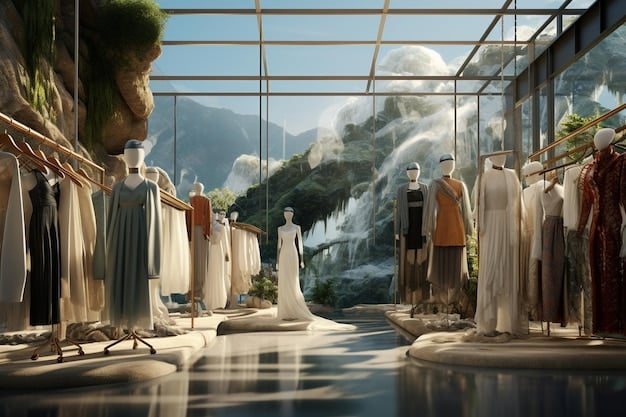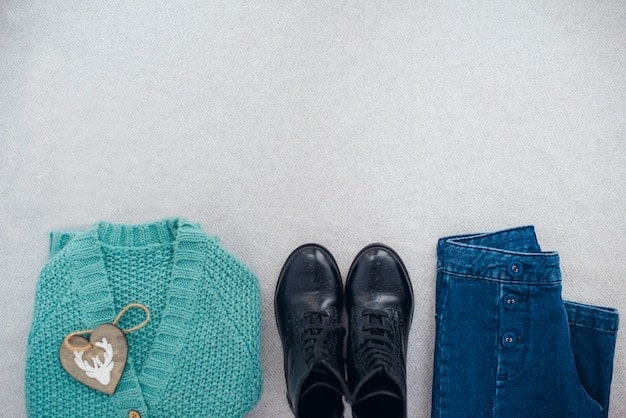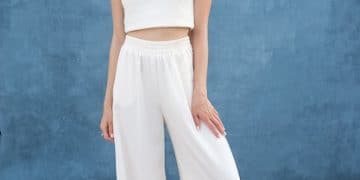Gender-Neutral Fashion: Breaking Barriers in 2025 – A New Era of Style

Anúncios
Looking ahead to 2025, gender-neutral fashion is not merely a trend but a transformative movement, challenging traditional sartorial norms and championing inclusivity and self-expression through fluid design aesthetics and innovative retail strategies.
The fashion landscape is in constant flux, but few shifts are as profound as the rise of gender-neutral fashion: Breaking Down the Barriers in 2025. This isn’t just about oversized hoodies or utilitarian uniforms; it’s a fundamental reimagining of how we perceive and consume clothing, offering a liberating approach where garments are designed and marketed without specific gender assumptions.
The Evolution of Gender-Neutral Fashion: A Historical Perspective
Understanding the trajectory of gender-neutral fashion requires a look back at its roots, revealing that the concept, while seemingly contemporary, has historical parallels. Historically, clothing often served functional purposes or indicated social status rather than rigid gender definitions, evolving to reflect societal changes and challenging prevailing norms.
In various eras, men and women shared similar garments, from draped tunics in ancient civilizations to elaborate robes and high heels in the European courts of the 17th century. The Victorian era, however, saw a sharp divergence, assigning restrictive silhouettes and colors to each gender, a division that largely persisted through the 20th century. Yet, even within these constraints, pioneers emerged.
Early Seeds of Androgyny and Rebellion
The early 20th century, particularly post-World War I, witnessed the first significant cracks in traditional gendered dressing. Women adopted more practical attire, influenced by workwear and the suffrage movement, embracing trousers and less restrictive silhouettes. Icons like Marlene Dietrich and Katharine Hepburn popularized the tailored suit for women, subtly challenging entrenched gender boundaries.
- Coco Chanel’s contributions: Introduced women to comfortable, menswear-inspired silhouettes.
- 1960s youthquake: Unisex trends emerged, blurring lines with shared styles like bell-bottoms.
- David Bowie’s influence: The 1970s saw a flamboyant embrace of gender fluidity in pop culture.
- Grunge and streetwear: The 1990s offered oversized, non-gendered casual wear as a rebellion.
These early movements paved the way for a more explicit conversation about gender identity and expression in clothing, setting the stage for the comprehensive gender-neutral movement we observe today. The shift from “unisex” to “gender-neutral” signifies a deeper philosophical change, moving beyond simply shared items to deliberately designed clothing that transcends binary categorizations.
The historical evolution demonstrates that fashion is a mirror of society. As societal norms around gender become more fluid and inclusive, so too does our approach to clothing, moving from subtle hints of rebellion to a fully articulated philosophy of design.
Drivers of Change: Why Gender-Neutral Fashion is Thriving in 2025
The current surge in gender-neutral fashion isn’t arbitrary; it’s fueled by several powerful societal, cultural, and economic forces converging to redefine what we wear and how we perceive style. By 2025, these drivers have become even more pronounced, solidifying its place in the mainstream.
At its core, the movement is a direct response to evolving gender identities and the growing recognition that gender is a spectrum, not a binary. Younger generations, particularly Gen Z, are leading this charge, displaying a significant rejection of traditional gender stereotypes in all aspects of their lives, including dress. They value authenticity and self-expression above conformity.
Societal Shifts and Consumer Values
The rise of social media has amplified diverse voices and lifestyles, showcasing a myriad of ways to express oneself, thereby normalizing non-binary gender expressions and fluid fashion choices. Influencers and public figures actively embrace and promote gender-neutral styles, making them aspirational and accessible to a wider audience. This visibility is crucial for widespread adoption.
- Increased LGBTQ+ awareness: Greater visibility and acceptance drive demand for inclusive products.
- Focus on individuality: Consumers prioritize personal expression over outdated norms.
- Sustainability concerns: Gender-neutral lines often align with ethical production and less consumption.
- Economic pragmatism: Brands see opportunities in broader market appeal and reduced inventory complexity.
Furthermore, the pandemic inadvertently played a role, accelerating a cultural shift towards comfort and practicality. As people spent more time at home, the boundaries between formal and casual, and male and female, blurred. This fostered a greater appreciation for versatile, comfortable clothing that doesn’t constrain or categorize.
Brands, recognizing these shifts, are adapting their design processes, marketing strategies, and retail environments to cater to this burgeoning market. This isn’t just about “woke washing”; it’s a genuine response to consumer demand and an understanding that inclusivity is not just morally right, but also good business in 2025.

Design Principles and Aesthetics of Gender-Neutral Clothing
Designing for inclusivity goes beyond simply removing gender labels; it involves a thoughtful approach to silhouette, fit, color, and fabric. By 2025, the aesthetics of gender-neutral fashion have matured into a distinct and compelling language that prioritizes versatility and individual expression.
The primary goal is to create garments that can be worn and styled comfortably by anyone, regardless of their gender identity. This often translates into relaxed, adaptable fits that aren’t tailored to specific body shapes, moving away from hyper-feminine or hyper-masculine contours.
Key Design Characteristics and Evolving Styles
Silhouettes tend to be looser, featuring straight cuts, oversized proportions, and adjustable elements. Think of relaxed-fit trousers, oversized blazers, and flowing shirts that drape rather than cling. This allows for a comfortable fit across a wider range of body types and enables diverse styling options.
- Versatile Silhouettes: Focus on straight, relaxed, and oversized cuts suitable for diverse body shapes.
- Neutral Color Palettes: Utilizes earthy tones, monochrome, and subtle hues, though pops of color are increasingly common.
- Adaptive Sizing: Often uses numerical or descriptive sizing (e.g., S, M, L) rather than gender-specific labels.
- Functional Details: Incorporates practical elements like adjustable waistbands, multiple pockets, and durable fabrics.
Fabric choices are also crucial, favoring materials that are comfortable, durable, and possess a good drape, such as cotton, linen, Tencel, and blends. Textiles with a universal appeal and tactile softness enhance the comfort and wearability for everyone.
While neutral color palettes (blacks, grays, whites, earthy tones) are common, reflecting a minimalist aesthetic, contemporary gender-neutral collections in 2025 are increasingly incorporating bolder colors and prints. The key is that these colors aren’t associated with a particular gender, allowing for individual interpretation.
Ultimately, the design principles of gender-neutral fashion emphasize comfort, adaptability, and an aesthetic that champions personal style over prescribed gender norms. It’s about utility meeting elegance, creating pieces that serve as building blocks for a truly inclusive wardrobe.
Retail and Marketing Strategies for a Gender-Neutral World
As gender-neutral fashion accelerates into 2025, retailers and brands are rapidly recalibrating their strategies, moving beyond mere product offerings to encompass inclusive marketing, innovative store layouts, and ethical sourcing. This shift reflects a deeper understanding of the modern consumer who values authenticity and purpose.
No longer is it enough to simply offer “unisex” t-shirts; true gender-neutral retail creates environments where all individuals feel seen, respected, and empowered to explore their personal style without judgment. This involves fundamental changes to how merchandise is presented and how brands communicate their values.
Rethinking the Shopping Experience
One of the most visible changes is the retail space itself. Traditional “menswear” and “womenswear” sections are being dismantled in favor of integrated displays organized by garment type, style, or collection. This encourages cross-gender browsing and removes subliminal gender messaging during the shopping process.
- Integrated Store Layouts: Merging traditional men’s and women’s sections into fluid, boundary-less zones.
- Inclusive Marketing Campaigns: Featuring diverse models and real people across the gender spectrum.
- Online Experience Redesigns: Websites allow filtering by style or fit, not just gender.
- Community Building: Brands foster spaces for dialogue and engagement around diverse identities.
Marketing has become significantly more inclusive. Campaigns feature a wide range of models who embody various gender expressions, body types, and ethnicities, moving away from hyper-gendered poses and stereotypes. Communication emphasizes versatility and self-expression rather than catering to specific gender archetypes.
Online, brands are implementing advanced filtering options that allow consumers to search by fit, style, or collection rather than defaulting to “men’s” or “women’s.” Virtual try-on technologies are also becoming more sophisticated, allowing users to visualize garments on different body shapes, further enhancing the non-binary shopping experience.
The successful retail and marketing strategies in 2025 are those that embody the core values of gender neutrality: respect for individual identity, celebration of diversity, and a commitment to creating a friction-free, empowering shopping journey for everyone.
The Impact on Traditional Fashion Norms and Industries
The rise of gender-neutral fashion is not merely an addition to the industry; it’s a powerful disruption, fundamentally re-shaping traditional fashion norms and sending ripples through various industrial segments. By 2025, its influence is evident in design schools, supply chains, and even broader cultural conversations.
Historically, the fashion industry has operated on a deeply binary model, with separate design teams, production lines, marketing budgets, and even physical store layouts for “men’s” and “women’s” clothing. Gender-neutrality challenges this foundational split, promoting a more integrated and flexible approach.
Shaking Up the Status Quo
One of the most significant impacts is on creativity and innovation. Designers are encouraged to think beyond predefined gender roles, fostering a more expansive and imaginative approach to clothing creation. This leads to more exciting, functional, and universally appealing designs that break free from historical constraints.
- Fluid Design Education: Fashion schools are adapting curricula to include gender-neutral design principles.
- Supply Chain Re-evaluation: Streamlining production processes previously segmented by gender.
- Reduced Waste: Potentially lower inventory and fewer unsold gender-specific items.
- Challenging Advertising Norms: Force a re-think of how clothing is presented and who it targets.
Production and supply chains are also adapting. While some brands maintain separate lines, many are exploring unified sizing charts and manufacturing processes that can efficiently produce garments suitable for a broader demographic. This could lead to economies of scale and reduced waste from overproducing gender-specific items.
Furthermore, the movement challenges the very notion of “fashion week” divisions and editorial spreads, often pushing for combined shows and features that blend and blur what was once strictly separated. This cross-pollination of ideas and styles creates a richer, more dynamic fashion ecosystem.
The long-term impact suggests a more agile, relevant, and responsible fashion industry. As traditional norms are dismantled, what emerges is a landscape less defined by rigid gender categories and more by individual expression, sustainability, and ethical production practices, setting a new benchmark for 2025 and beyond.
Challenges and Critiques Facing Gender-Neutral Fashion
While the momentum behind gender-neutral fashion is undeniable by 2025, its journey is not without hurdles. Like any significant cultural shift, it faces practical challenges in production, consumer adoption, and even philosophical critiques that necessitate careful consideration and nuanced responses.
One of the primary practical challenges lies in sizing and fit. Human bodies are diverse, and traditional gendered sizing has developed over centuries to cater to perceived average male and female forms. Creating garments that truly fit and flatter such a wide range of body types without specific tailoring remains a complex design and engineering feat.
Overcoming Obstacles to Widespread Adoption
Consumer perception is another significant barrier. Despite growing acceptance, deeply ingrained societal norms still associate certain garments with specific genders. Educating consumers and shifting these long-held perceptions requires time, persistent marketing, and consistent availability of appealing options.
- Sizing Complexity: Developing universal sizing that comfortably fits diverse body types.
- Consumer Resistance: Overcoming traditional perceptions and ingrained habits of gender-specific shopping.
- Design Uniformity Trap: Avoiding bland or shapeless designs in an effort to be “neutral.”
- Retailer Adaptation: Requiring significant investment in reconfiguring store layouts and marketing.
There’s also a risk of stylistic uniformity. In an effort to be universally appealing, some early gender-neutral collections have been criticized for offering overly simplistic or utilitarian designs that lack distinctiveness or strong aesthetic appeal. The challenge is to maintain creativity and individual flair while shedding gendered constraints.
From an industry standpoint, adapting established supply chains and retail infrastructures can be costly and requires significant investment. Brands must decide how to transition without alienating their existing customer base while attracting new ones. This dual objective demands strategic planning and execution.
Despite these challenges, the progress made by 2025 indicates that the industry is committed to overcoming them. Through innovative design, clever marketing, and a deeper understanding of consumer needs, gender-neutral fashion continues to evolve, proving its resilience and long-term viability.
The Future Landscape: What’s Next for Gender-Neutral Fashion Post-2025
Looking beyond 2025, the trajectory of gender-neutral fashion suggests a continued deepening of its influence, moving from a niche trend to an integral part of the mainstream fashion paradigm. The future promises greater integration, technological innovation, and a global reach.
One significant development will be the increasing adoption by more traditional high-fashion houses, not just as capsule collections but as core components of their seasonal offerings. This will further legitimize the movement and introduce these aesthetics to a broader luxury market.
Innovation, Integration, and Global Reach
Technology will play an even greater role. Advanced 3D body scanning, AI-driven fit recommendations, and virtual try-on experiences will become standard, allowing for hyper-personalized sizing and styling that truly caters to individual body shapes without gender assumptions. This will mitigate current sizing challenges.
- Hyper-Personalization: AI and 3D scanning will enable perfect fit for all body types.
- Circular Economy Integration: Gender-neutral design supports upcycling and repair more easily.
- Broader Market Adoption: From luxury to mass-market, its principles will be ubiquitous.
- Educational Reform: Fashion education will inherently teach inclusive design from day one.
The concept of “gender-neutral” will also become more nuanced. It won’t just be about discarding gender; it will be about celebrating the spectrum of human expression. We may see styles that playfully incorporate traditionally feminine or masculine elements in novel, non-binary ways, pushing creative boundaries even further.
The intersection with sustainability will also strengthen. Gender-neutral designs, often characterized by timelessness and versatility, naturally align with principles of circular fashion, encouraging less consumption and more durable, adaptable wardrobes. This inherent compatibility will drive both movements forward together.
Ultimately, post-2025, gender-neutral fashion won’t be a separate category but a foundational principle of modern design. Clothing will be increasingly seen as a form of art and self-expression, unburdened by archaic gender constructs, making fashion a truly universal language.
| Key Aspect | Brief Description |
|---|---|
| 👕 Design Philosophy | Focuses on versatile, comfortable silhouettes suitable for all body types. |
| 📈 Market Drivers | Driven by Gen Z values, inclusivity, and evolving gender identities. |
| 🛒 Retail Impact | Leads to integrated store layouts and inclusive marketing campaigns. |
| 🔮 Future Outlook | Expected to be a foundational principle, aided by tech and sustainability. |

Frequently Asked Questions about Gender-Neutral Fashion in 2025
In 2025, gender-neutral fashion is defined by clothing designed and marketed without specific gender assumptions. It transcends traditional binaries, focusing on versatile silhouettes, adaptive sizing, and inclusive aesthetics, allowing individuals to express themselves freely regardless of their gender identity. It champions comfort, fluidity, and personal style over gendered categorization.
While often used interchangeably, “unisex” typically refers to items designed to fit both genders, often by making them generic or oversized, like a basic t-shirt. “Gender-neutral” goes deeper, implying a deliberate design philosophy that transcends gender entirely, focusing on aesthetic and functional inclusivity from the ground up, not just shared sizing.
Its growth in 2025 is primarily driven by shifting societal attitudes towards gender, particularly among Gen Z. Increased LGBTQ+ visibility, a strong focus on individuality, demands for authenticity, and alignment with sustainability goals also play crucial roles. Social media amplification and brands adapting to these consumer values further accelerate the trend.
Styling gender-neutral clothing is about personal expression. Key tips include experimenting with layering, playing with proportions (e.g., oversized top with tailored bottoms), and using accessories to define your look. Focus on comfort and confidence, mix and match pieces, and don’t be afraid to break traditional norms to create a unique personal style.
Challenges include developing truly universal sizing that accommodates diverse body types effectively, overcoming deeply ingrained consumer perceptions regarding gendered clothing, and avoiding overly uniform or bland designs. Retailers also face the hurdle of reconfiguring traditional store layouts and marketing strategies to fully embrace this inclusive approach.
Conclusion: A More Inclusive Wardrobe for a Fluid World
The journey of gender-neutral fashion to 2025 is a testament to society’s evolving understanding of identity and expression. What began as a subtle challenge to rigid sartorial norms has blossomed into a powerful, liberating force, reshaping how we design, market, and consume clothing. It’s more than just a trend; it’s a fundamental paradigm shift towards a more inclusive and authentic approach to style, reflecting a world that celebrates diversity in all its forms. As we move forward, gender-neutral fashion will continue to break down barriers, offering a wardrobe that truly welcomes everyone.





